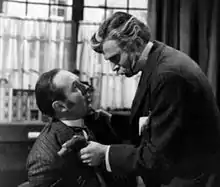A Place of One's Own
A Place of One's Own is a 1945 British film directed by Bernard Knowles. An atmospheric ghost story based on the novel by Osbert Sitwell, it stars James Mason, Barbara Mullen, Margaret Lockwood, Dennis Price and Dulcie Gray. Mason and Mullen are artificially aged to play the old couple. It was one of the cycle of Gainsborough Melodramas.
| A Place of One's Own | |
|---|---|
 Screenshot | |
| Directed by | Bernard Knowles |
| Produced by | R.J. Minney |
| Written by | Brock Williams |
| Based on | novel by Osbert Sitwell |
| Starring | James Mason Barbara Mullen Margaret Lockwood Dennis Price Dulcie Gray |
| Music by | Hubert Bath |
| Cinematography | Stephen Dade |
| Edited by | Charles Knott |
Production company | |
| Distributed by | Eagle-Lion Distributors |
Release date |
1949 (USA) |
Running time | 92 minutes |
| Country | United Kingdom |
| Language | English |
Plot
The Smedhursts, newly retired, buy Bellingham House, which has been vacant for over 40 years and is rumoured to be haunted by the previous owner, Elizabeth, who is widely believed to have been murdered by her guardians. Mrs Smedhurst employs a young lady, Annette, as a companion. Annette becomes haunted by Elizabeth, who is waiting for her lover, Dr Marsham. Mr Smedhurst asks the police to find Dr Marsham, and he comes to visit Annette/Elizabeth. The next morning, everyone in the house feels "lighter" and Annette wakes up recovered. A local policeman arrives and announces that Dr Marsham has been found but will not be able to visit as he has died...
Cast
- Margaret Lockwood as Annette
- James Mason as Mr. Smedhurst
- Barbara Mullen as Mrs. Smedhurst
- Dennis Price as Dr. Selbie
- Helen Haye as Mrs. Manning-Tutthorn
- Michael Shepley as Major Manning-Tutthorn
- Dulcie Gray as Sarah
- Moore Marriott as George
- O. B. Clarence as Perkins
- Helen Goss as Rosie, the Barmaid
- Edie Martin as Cook
- Gus McNaughton as Police Constable Hargreaves
- Muriel George as Nurse
- John Turnbull as Sir Roland Jervis
- Ernest Thesiger as Dr. Richard Marsham
- Henry B. Longhurst as Inspector
- Aubrey Mallalieu as Canon Mowbray
Production
The film was based on a novel published in 1942.[1]
James Mason wrote in his memoirs that when he read the script "not only did I enthuse but I even asked that I might be permitted to play the role of the elderly retiree in the story."[2]
This was the first time Margaret Lockwood used a beauty spot on her cheek in a film, something which became a trademark.[3]
Reception
According to Kinematograph Weekly the film performed well at the British box office in 1945.[4][5]
Considering the popularity at the time of stars James Mason and Margaret Lockwood, however, the film was considered a financial disappointment. Mason later wrote in his memoirs that the blame needed to be shared between himself, for wanting to play the role, and the producer, for letting him.
Of course it could have turned out a failure even if the most suitable actor in the world had played that part. But the reactions of the top brass at the studio did nothing to allay my own feeling of guilt for having volunteered my services. In any case it was not that I was incapable of turning my hand to a character part, it was just that I had amassed what I always realized was an absurd degree of popularity, and the fan population wanted me to appear only as some heroic young lady-killer; or better-still, ladybasher.[2]
He also blamed director Bernard Knowles:
Knowles deserved his share [of blame] because he had never got over Citizen Kane and still thought that it was a shortcut to success if one had the actors play immensely long sequences without any intercutting or covering shots. In Citizen Kane the director could afford to do this because Herman Mankiewicz had revised one strong situation after another.[2]
The film was not released in the US until 1949.
References
- "FACT OR FICTION?". The Sydney Morning Herald (32, 647). New South Wales, Australia. 15 August 1942. p. 6. Retrieved 12 April 2016 – via National Library of Australia.
- James Mason, Before I Forget, quoted in A Place of One's Own at Turner Classic Movies
- Margret Lockwood obitury at The Times July 1990
- Robert Murphy, Realism and Tinsel: Cinema and Society in Britain 1939-48 2003 p 208
- Thumim, Janet. "The popular cash and culture in the postwar British cinema industry". Screen. Vol. 32 no. 3. p. 258.
External links
- A Place of One's Own at IMDb
- A Place of One's Own at Britmovie
- A Place of One's Own at the TCM Movie Database
- A Place of One's Own at AllMovie
- Review of film at Variety
- Review of film at The New York Times
- Complete film at Internet Archive